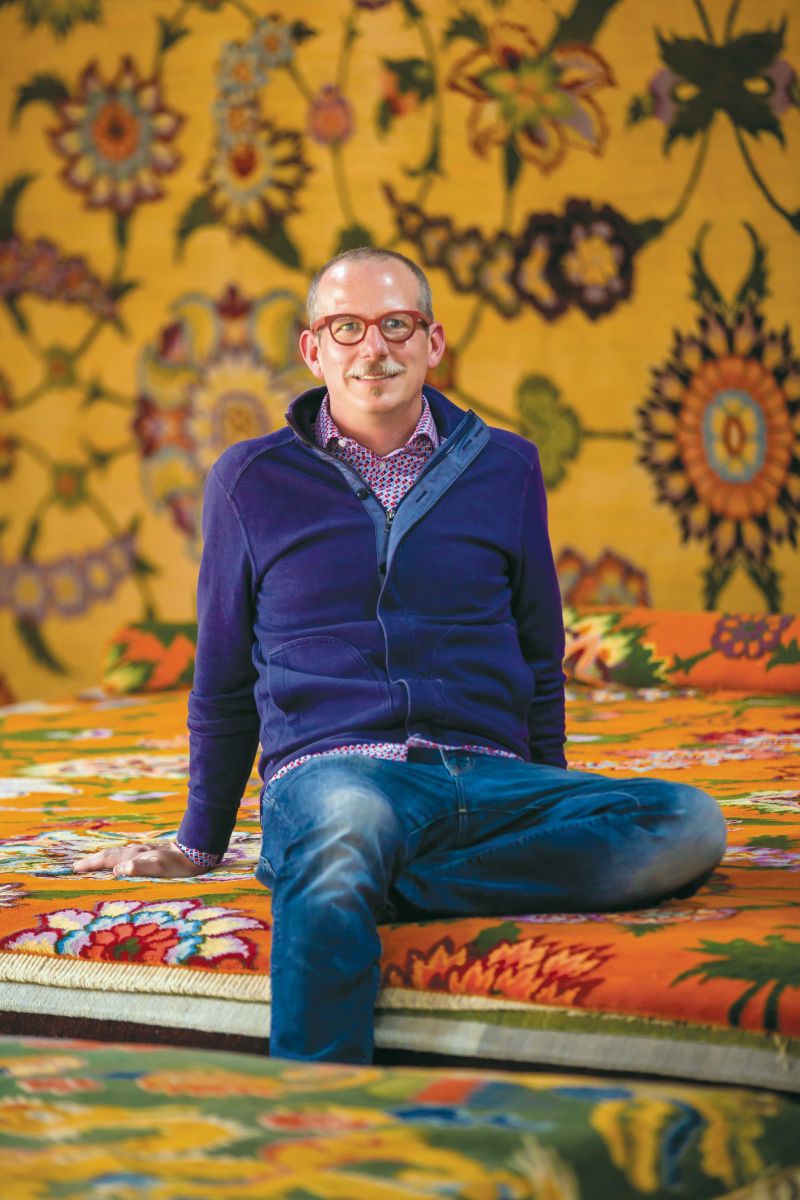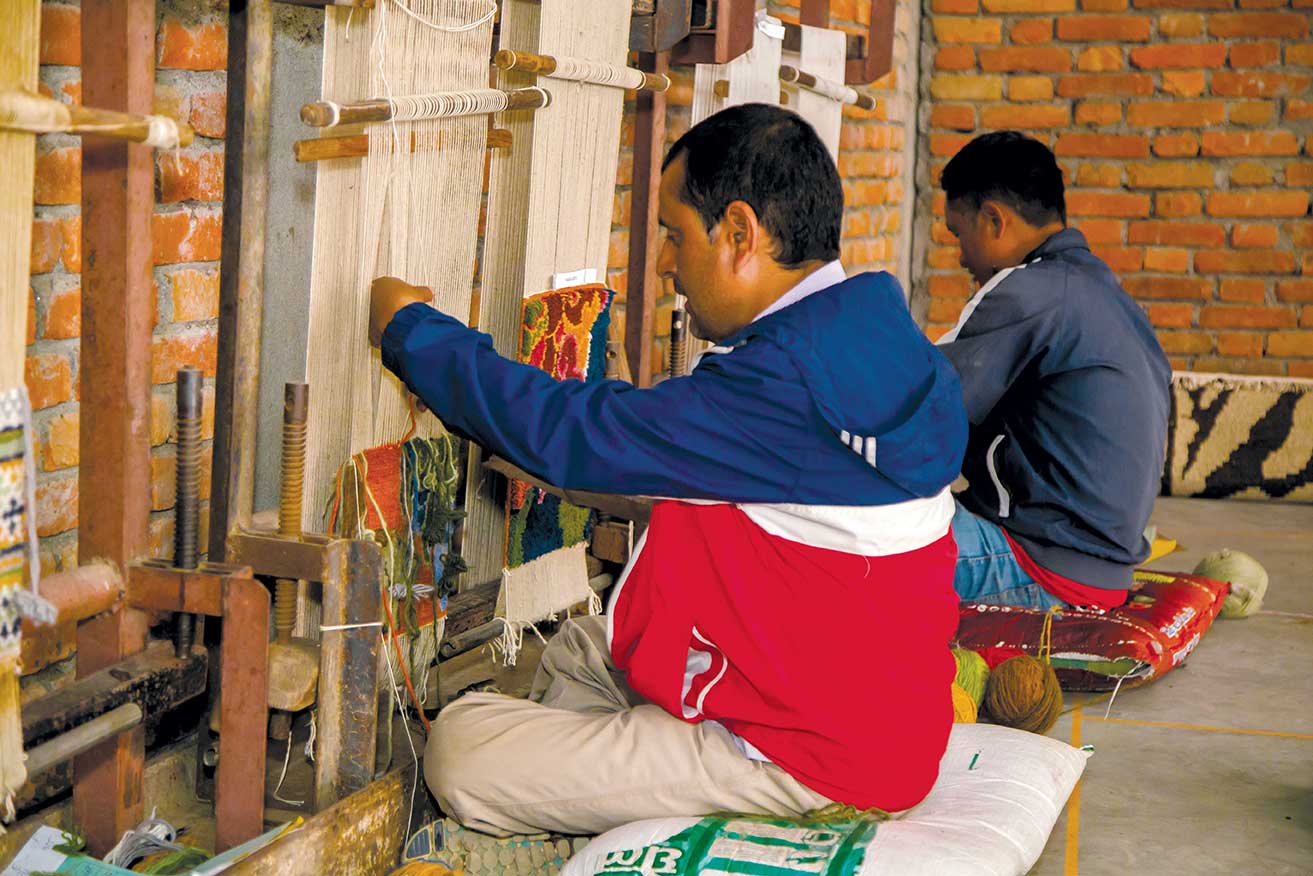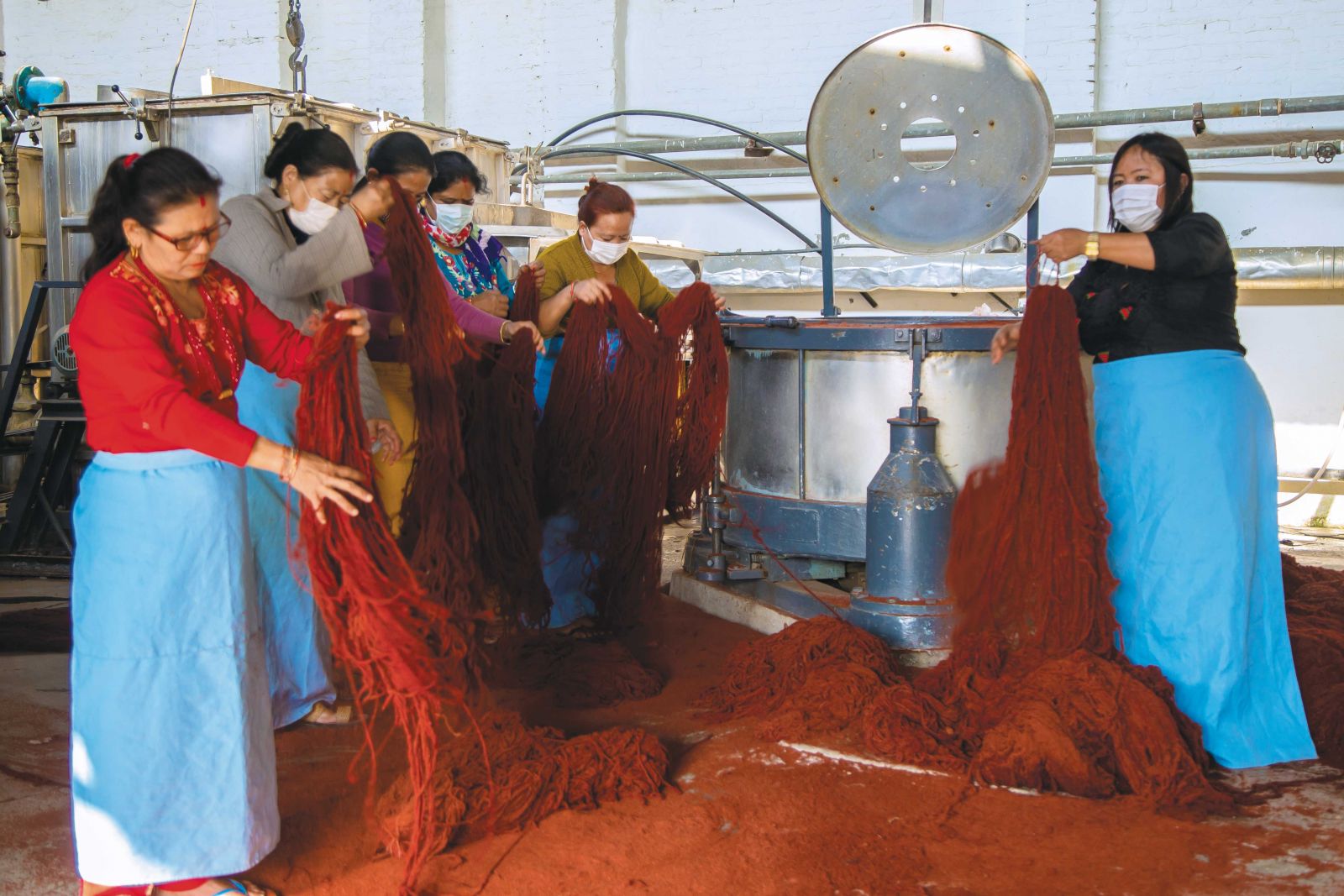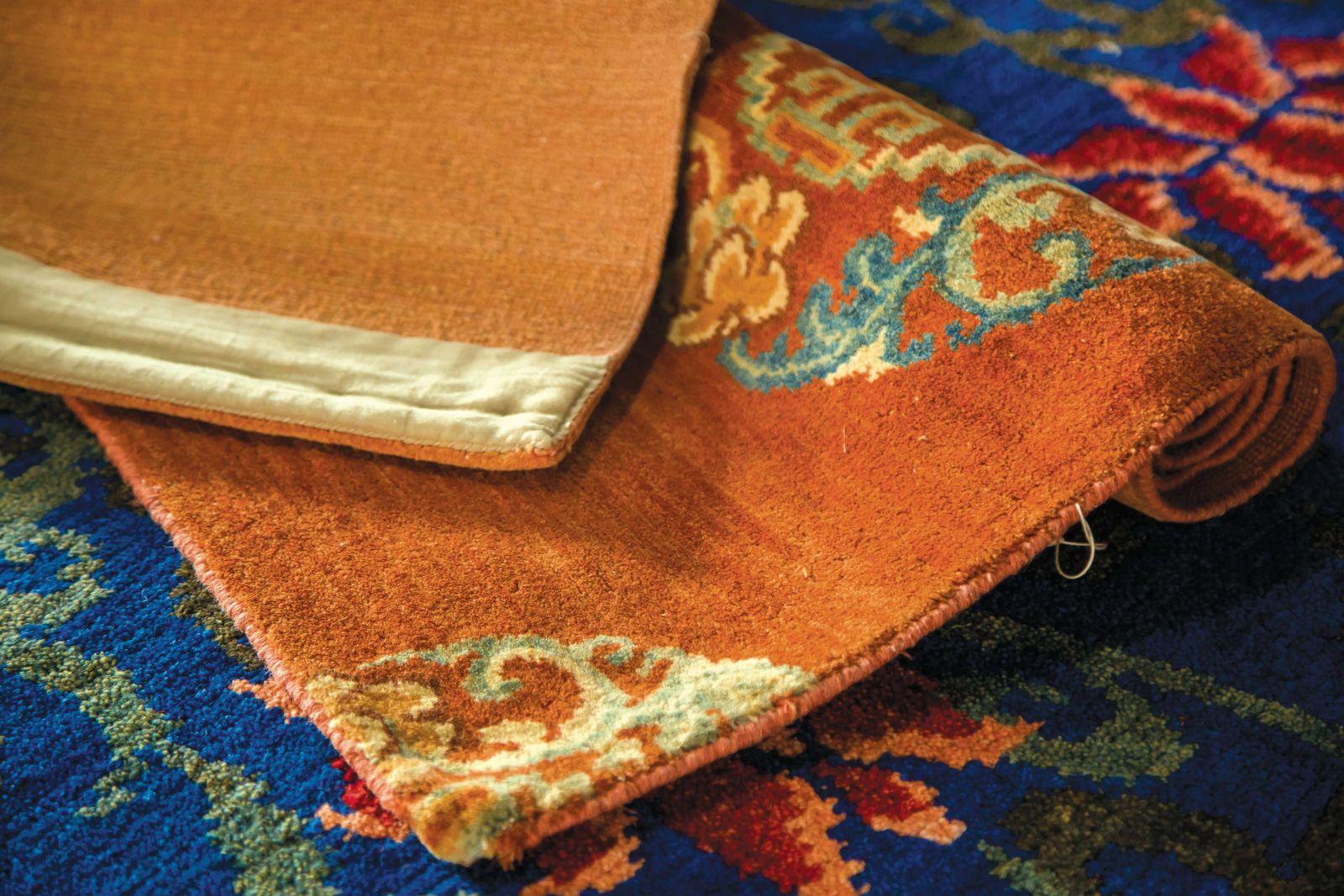
As preface to these answers I would like to say that while many people consider me an expert - a distinction I have reluctantly come to accept - in truth I am simply a human who as a young adult found a love and passion for Tibetan style carpets made in Nepal. Over the years this appreciation has afforded me many opportunities in life that would not exist had it not been for the talented, creative, imaginative, and hardworking people who live in Nepal, be they Nepali, Tibetan, expats, or otherwise. It is a country that inspired my love of modern design, and though karma is such that I have only been traveling to Nepal since 2016, it is a place I love and admire deeply. Some of the happiest moments of my career have been because of Nepal, and it is home to many dear friends and colleagues. I remain eternally blessed by these connections.
As a writer and expert, it is imperative I continuously learn, thus I always welcome meeting new people, seeing new weaving techniques, and experiencing the Nepali carpet industry from the perspective of those who actually make the carpets. Too often the stories of contemporary rugs and carpets are told from the perspective of those in the occident who design or commission their creation. In reality this is only one view, one perspective of myriad. If we all, as humans inhabiting this earth for only one lifetime or for many, take a moment to consider the thoughts and differing conditions of our friends, neighbors, countrymen, and strangers then perhaps we shall find solutions to the many real problems we face.

1) How did you get involved in the carpet industry in general, and Nepal's in particular?
In 1995 I was a young man who had recently quit university due to a restless spirit and a lack of intention in my studies. I began by studying engineering, then mathematics, and then also interior design. It is the latter that most closely resonated with my spirit, yet the path of my life remained unclear. I began working at a retail rug and carpet showroom tending to vacuuming, maintenance, and general labor. Over the course of two years I was promoted to salesman and then Assistant Manager, yet I found the style of rugs we sold - predominantly traditional Persian style - uninspiring and I actively searched for new employment. This changed in 1997 when I was first introduced to Tibetan-style carpets made in Nepal. (Footnote: The first carpets I fell in love with were made by Ranta Carpets and thus I feel it is most auspicious we photographed for this piece there.) The superior quality of their craftsmanship and materials, the singular beauty of their aesthetics, the apparent modernity of the designs, everything about them inspired me to remain in the carpet business. At the time I knew little of Nepal, but now, almost a quarter century later, I realize had it not been for this country my life would have taken a very different path.
My involvement such as it is now, including being the Honorary Brand Ambassador of Nepali Carpets of the Nepal Carpet Manufacturers and Exporters Association (NCMEA) came from this simple appreciation of the beauty and craft of another culture and its peoples; an affinity difficult to quantify other than to say I fell in love with Nepali-Tibetan carpets and love often defies explanation.

2) How is Nepal's carpet industry different from that in other countries? Can you tell us a little about its history from your perspective?
Nepal’s carpet industry differs from other contemporaneous rug and carpet producing countries in that historically the weaving of carpets is relatively newfound, having only really come to Nepal with the influx of Tibetan refugees following the annexation of Tibet via the Seventeen Point Agreement in 1950 by the People’s Republic of China and the subsequent exile of the Dalai Lama. Following the exodus of Tibetans to Nepal, the then King of Nepal, King Mahendra, granted status to these refugees who later began weaving carpets in the Kathmandu Valley as a source of income. It was not until the late 1980s and early 1990s, however, that the carpet industry as we know and understand it today truly began to develop.
Seminal work done in collaboration between Westerners with a keen eye for aesthetics and Tibetans with immense and inimitable technical understanding of carpetry - the craft of carpet making - combined to create rapid growth in the industry. This period is known colloquially as ‘The Golden Era’ and the volume of carpets produced during this era has not been matched since. Carpet making in Nepal brought and continues to bring much needed foreign exchange to the country and has helped the country economically. While the volume of carpets made in Nepal has declined greatly since the ‘Golden Era,’ innovations in quality, technique, and production methods have transformed the industry from one known for making relatively simple designs for mass export into what is today the world’s preeminent producer of made-to-order custom carpets of nearly unimaginable complexity.

3) What do you see as the industry's strengths and weaknesses?
Certainly it is easy to point to the ability and willingness of the industry to produce made-to-order custom carpets as a predominant commercial strength but there are others of equal social importance which must be mentioned. The industry provides income for classes of people seeking to better their own lives and the lives of their children and for whom other employment opportunities simply do not exist. While both men and women weave, the role of weaver is still one largely filled by women, providing them with a means of earning their own income and contributing to not only their family but modern society as a whole.
Commercially speaking the relatively high cost of labor in Nepal is generally seen by the traditional industry as a competitive weakness though I feel this can be exploited to the benefit of Nepal. Instead of focusing on this as a negative, perhaps it is an opportunity to re-evaluate the industry and chart a new course forward by positioning Nepali-made carpets as ones that provide fair and equitable income to those who weave and craft carpets within the context of the Global South, that is to say developing countries. It is not always an easy calculus given the realities of today. The same digital technology which helped transform the industry now also offers weavers direct access to information previously outside of their reach. While I don’t think it is yet pervasive, imagine for a moment that the person weaving a carpet can now - via social media - come to realize the money being made from their work, as well as the lifestyles afforded others. In an age of so-called transparency this is a reality we must come to terms with.

4) To move forward most effectively into the future, do you think Nepal's carpet companies need to modernize or stick to the very traditional?
Success never comes without modernization, or say another way, without change. For those seeking to purchase carpets in the Kathmandu Valley proper it is easy to perceive the aesthetic as still decidedly traditional; the vast majority of rug shops often cater to Tibetans or the Chinese market with traditional designs and colorations. On the other hand, rugs and carpets made for direct export are already predominantly distinctly modern, owing to Western influence on their design and crafting. As such, one could say that the industry exists with one foot in the past and one foot in the future, balancing the needs and wants of different consumers. To move forward, the Nepali carpet industry must look to emerging consumer markets and demographics, not only predicting where carpets may be sold in the future but also discerning the aesthetics that will resonate with those new markets. From the Golden Era until now, design and consumption have been catering to Western markets, namely the United States and Europe. As economies of the world progress and consumer demographics shift, the wise course of action is to follow suit and attempt to provide for those new markets. At the same time Nepal should not abandon its existing customers but it must realize that the consumption patterns of the past are likely never to return and likewise must adapt accordingly. New distribution models are currently being and must be developed to meet the demands of today. The intrinsic characteristics of a Nepali-Tibetan carpet are what makes the brand, irrespective of design and whether created by a Nepali or Western or otherwise designer. As such, we must acknowledge all of these factors in attempting to find a modernized version of the industry.
5) Can you tell us more about the new trend of customized carpets?
It is interesting that you frame the concept of customization as a new trend, though perhaps this is - as mentioned elsewhere - a matter of perspective. As a former salesman I recall ordering custom carpets from Nepal in the late 1990s, though at the time the process was tedious, cumbersome, slow, and often error prone. This changed due to several factors, but digital technology must be recognized as the predominant force behind the industry’s shift from producing stock carpets to made-to-order custom carpets. The ease of communication brought about by the internet as well as the efficiencies in design layout and graphing brought about by Kathmandu’s own Alternative Technology make the process of customization relatively easy. At the same time, consumer demand in the West is now driven by the interior design community which specializes in promoting unique and individual interiors. This serendipitous confluence of ability to produce and desire to consume created the made-to-order custom carpet business of today.
6) Related to question 4 above, what do you think is the future of the industry here going ahead?
The future is most certainly not in trying to compete on price with other current or future developing rug producing countries. One can always find less expensive and cheaper rugs and carpets and the urge to try and compete in this manner is misguided. Nepal has a strong tradition of creativity and quality and now paired with more equitable wages is poised to offer a handcrafted product relatively unique in the world, again within context. As the progeny of the rich history of Tibetan carpetry, Nepali made rugs offer unmatched character and owing to the use of Tibetan Highland Sheep’s Wool remain distinct, and one could argue superior, to similarly styled carpets made elsewhere. Instead of attempting to and then failing at competing on price - which can only come via substandard wages, again within context, and at the expense of quality - the industry must focus on absolute superior quality in every form. Certainly this market will be smaller than it has been in the past, but for those consumers who seek the best, it can be argued that Nepal offers precisely.
Of course, this assumes all rugs made in Nepal are of superior quality and we must also acknowledge that this is not the case. To truly distinguish itself in in the global market as not only the preeminent producer of made-to-order custom carpets but also as the standard bearer of utmost quality, the Nepali carpet industry would be wise to adopt and enforce - for those willing to participate if not also mandated by authorities, a decision best left to the people themselves - minimum quality standards so that consumers purchasing a Nepali made carpet have absolute trust in its construction, quality, durability, and the like. In short, voluntary minimum standards developed by an industry association or guild would lead to the creation of the brand of Nepali carpets recognized by consumers everywhere as the hallmark of authenticity and quality. It’s terroir, it’s a Nepali version of an appellation d'origine contrôlée, a designation in France which, for example, designates what may and may not be called champagne, except of course addressing carpets. To do this we must realize, as I have come to learn from my association with friends in Nepal, that the question is not one of whether the industry needs to adapt, but is one of what what adaptations need to be made.
A short primer on the art of carpet making in Nepal
Nepali-Tibetan carpet making begins, as it must, with the sourcing of raw materials. Tibetan Highland Sheep’s wool has been the preferred material of choice for the industry but other wools, such as that from New Zealand as well as a variety of natural fibres such as silk, nettle, aloe, and hemp, to name but a few, can also be used. These fibres can be processed entirely by hand, as has traditionally been the case, and also by machine which has gained prominence more recently. Once processed into finished yarns the materials then visit the dyemaster who transforms them from their natural color into a wide spectrum of hues tailored to the desires of carpet consumers. Once dried thoroughly in the golden Nepali sun the dyed yarns await the weaver who will handknot the design into a carpet.
The design itself can come from any source and while historically it was drawn by hand, nowadays the vast majority of carpets made in Kathmandu are made with the assistance of Galaincha Software from Kathmandu’s Alternative Technology, which allows for computerized processing of the design. Then by following the weaving graph, also called a cartoon or nakhshe, the weaver meticulously follows the design knot by knot, row by row, tying each knot in its correct predetermined location. For a 2.4M x 3.0M carpet this knotting and weaving process takes three weavers about two to three months depending on the complexity of the design. Once woven the rug is cut from the loom and sent for washing and finishing.
Filtered water alone, water and mild detergent, or water and an assortment of additives are used to wash the carpets with each specific process yielding different aesthetic and lustre finishes on the carpet. After washing the carpet is finished, which involves stretching and drying, again in the sun, binding, scissoring, and a long list of other minor steps that all serve to make the carpet ready for shipment to the customer. Once ready for shipment the rug is dispatched by air cargo to consumers the world over.


Regarding Ranta Carpets
Ranta Carpets is one of the older makers in the Kathmandu Valley and they are experts at not only the craft of carpet making but the materials and processing thereof, which result in truly great carpets. Employing both traditional as well as novel and innovative weaving techniques, the firm was a seminal player in developing the export market for rugs from the Kathmandu Valley. In fact, my love of Nepali weaving was inspired by carpets made by Ranta and to this day I have an affinity for their work.
Michael Christie, aka “The Ruggist” is Editor of Rug Insider and Honorary Brand Ambassador, NCMEA








